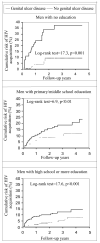Incident HIV infection among men attending STD clinics in Pune, India: pathways to disparity and interventions to enhance equity
- PMID: 14717571
- PMCID: PMC3516674
Incident HIV infection among men attending STD clinics in Pune, India: pathways to disparity and interventions to enhance equity
Abstract
Systematic disparities in rates of HIV incidence by socioeconomic status were assessed among men attending three sexually transmitted disease (STD) clinics in Pune, India, to identify key policy-intervention points to increase health equity. Measures of socioeconomic status included level of education, family income, and occupation. From 1993 to 2000, 2,260 HIV-uninfected men who consented to participate in the study were followed on a quarterly basis. Proportional hazards regression analysis of incident HIV infection identified a statistically significant interaction between level of education and genital ulcer disease. Compared to the lowest-risk men without genital ulcer disease who completed high school, the relative risk (RR) for acquisition of HIV was 7.02 (p < 0.001) for illiterate men with genital ulcer disease, 3.62 (p < 0.001) for men with some education and genital ulcer disease, and 3.02 (p < 0.001) for men who completed high school and had genital ulcer disease. For men with no genital ulcer disease and those with no education RR was 1.09 (p = 0.84), and for men with primary/middle school it was 1.70 (p = 0.03). The study provides evidence that by enhancing access to treatment and interventions that include counselling, education, and provision of condoms for prevention of STDs, especially genital ulcer disease, among disadvantaged men, the disparity in rates of HIV incidence could be lessened considerably. Nevertheless, given the same level of knowledge on AIDS, the same level of risk behaviour, and the same level of biological co-factors, the most disadvantaged men still have higher rates of HIV incidence.
Figures
Similar articles
-
Genital ulcer disease among STD clinic attenders in Nairobi: association with HIV-1 and circumcision status.Int J STD AIDS. 1996 Oct;7(6):410-4. doi: 10.1258/0956462961918374. Int J STD AIDS. 1996. PMID: 8940669
-
Correlates and trend of HIV prevalence among female sex workers attending sexually transmitted disease clinics in Pune, India (1993-2002).J Acquir Immune Defic Syndr. 2006 Jan 1;41(1):107-13. doi: 10.1097/01.qai.0000179428.49907.6d. J Acquir Immune Defic Syndr. 2006. PMID: 16340482 Free PMC article.
-
HIV infection in male patients attending a sexually transmitted disease clinic.J Med Assoc Thai. 1992 May;75(5):293-8. J Med Assoc Thai. 1992. PMID: 1460410
-
Sexually transmitted diseases and HIV infection: implications for control and prevention.J Indian Med Assoc. 1994 Jan;92(1):8-10. J Indian Med Assoc. 1994. PMID: 8207284
-
Epidemiology and control of sexually transmitted diseases in developing countries.Sex Transm Dis. 1994 Mar-Apr;21(2 Suppl):S45-50. Sex Transm Dis. 1994. PMID: 8042115 Review.
Cited by
-
A systematic review and meta-analysis of risk factors for sexual transmission of HIV in India.PLoS One. 2012;7(8):e44094. doi: 10.1371/journal.pone.0044094. Epub 2012 Aug 28. PLoS One. 2012. PMID: 22937158 Free PMC article.
-
Socio Behavioural Profile of HIV Positive DSC Personnel.Med J Armed Forces India. 2006 Oct;62(4):328-31. doi: 10.1016/S0377-1237(06)80098-5. Epub 2011 Jul 21. Med J Armed Forces India. 2006. PMID: 27688533 Free PMC article.
-
Predictors of retention among men attending STI clinics in HIV prevention programs and research: a case control study in Pune, India.PLoS One. 2011 Mar 11;6(3):e17448. doi: 10.1371/journal.pone.0017448. PLoS One. 2011. PMID: 21412414 Free PMC article.
-
Seroprevalence of HSV-1 and 2 in HIV-infected males with and without GUD: Study from a tertiary care setting of India.J Lab Physicians. 2018 Jul-Sep;10(3):326-331. doi: 10.4103/JLP.JLP_7_18. J Lab Physicians. 2018. PMID: 30078971 Free PMC article.
-
Assessment of sex-related behaviours, human immunodeficiency virus (HIV) knowledge and sexually transmitted infections (STIs) among men of reproductive age in Cameroon.Int J Environ Res Public Health. 2014 Dec 9;11(12):12726-38. doi: 10.3390/ijerph111212726. Print 2014 Dec. Int J Environ Res Public Health. 2014. PMID: 25500999 Free PMC article.
References
-
- India. Ministry of Health and Family Welfare. National AIDS Control Organization . Estimation of AIDS in India 2001. HIV/AIDS Indian scenario; [accessed on 10 September 2002]. http://naco.nic.in/vsnaco/indianscene/esthiv.htm.
-
- Braveman P, Tarimo E. Social inequalities in health within countries: not only an issue for affluent nations. Soc Sci Med. 2002;54:1621–35. - PubMed
-
- Starfield B, Shi L. Policy relevant determinants of health: an international perspective. Health Policy. 2002;60:201–18. - PubMed
-
- Over M. The effects of societal variables on urban rates of HIV infection in developing countris: an exploratory analysis, chapter 2. In: Ainsworth M, Fransen, Over M, editors. Confronting AIDS: evidence from the developing world. European Commission; Brussels: [accessed on 15 September 2002]. 1998. http://europa.eu.int/comm/development/body/theme/aids/limelette/html/lim....
-
- Farmer P. Infections and inequalities: the modern plagues. University of California Press; Berkeley: 2001. p. 375.
Publication types
MeSH terms
Grants and funding
LinkOut - more resources
Full Text Sources
Medical
Research Materials


